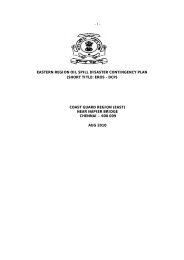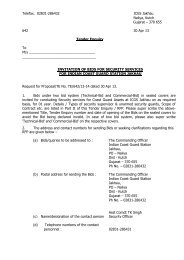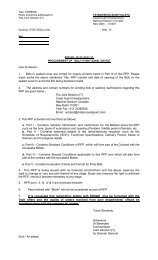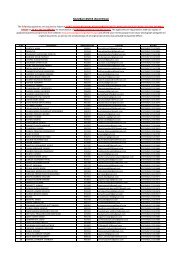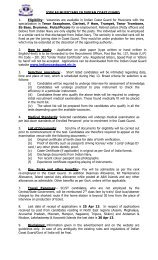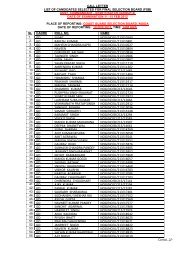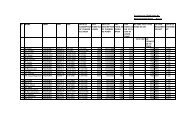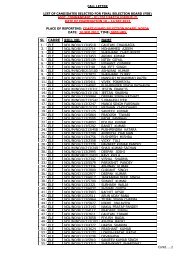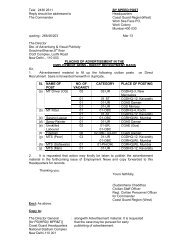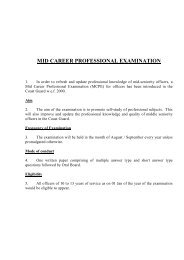ICGSMA Bulletin - Indian Coast Guard
ICGSMA Bulletin - Indian Coast Guard
ICGSMA Bulletin - Indian Coast Guard
Create successful ePaper yourself
Turn your PDF publications into a flip-book with our unique Google optimized e-Paper software.
<strong>ICGSMA</strong> BULLETIN (JAN - MAR 13)<br />
likely cause of the low idle RPM.<br />
DEFECT IDENTIFICATION<br />
After a detailed discussion with Senior<br />
Engineer Officer and Engineer Officer, it was<br />
decided to remove and dismantle the governor for<br />
speculating the defect.<br />
A team comprising of the Senior Engineer<br />
Officer and two ERAs worked towards DR of the DG<br />
set. On dismantling the governor drive end parts, it<br />
was observed that a small metallic chip with thread<br />
strands had got stuck with the oil pump suction<br />
strainer.<br />
THE DEFECT On starting of DG set, the hydraulic<br />
oil is pumped through the oil pump suction strainer<br />
to the power piston of the governor. The power<br />
piston movement is transferred to the PTR Fuel<br />
pump via mechanical linkage for maximum fuel<br />
rack during starting and for further RPM<br />
adjustment. As the oil strainer was choked, the<br />
pump ceased to develop sufficient pressure to<br />
operate the power piston which resulted in<br />
sluggish mechanical lever movement to fuel pump.<br />
DEFECT RECTIFICATION<br />
The suction strainer and pipe were cleaned<br />
with air and re-fitted with governor. Subsequently,<br />
trials were undertaken and found satisfactory at<br />
1500 RPM on both idle and with load conditions.<br />
OBSERVATIONS<br />
The position of the governor strainer was<br />
intricate to locate visually from oil filling cap.<br />
Despite oil renewal the obstruction from oil<br />
strainer was not cleared. This was the main reason<br />
for the team in speculating the cause of defect.<br />
LESSON LEARNT<br />
The governor without oil filling strainer<br />
may cause ingress of foreign matter into the sump<br />
during routines. Care should be taken that the oil is<br />
added carefully using a clean container with<br />
portable cloth or commercial plastic strainer.<br />
RECOMMENDATION<br />
This defect may minor in nature, but equally<br />
unique and rare. A lot of attention is needed to<br />
locate and avoid complexity of such defects. It is<br />
highly recommended that a renewable cup shaped<br />
plastic strainer be incorporated on the governor of<br />
the DG set to prevent any kind of blockage by<br />
impurities.<br />
A CASE STUDY - DEFECT ANALYSIS ON<br />
RO PLANT FOR LOW PERMEATE OUTPUT<br />
WITH HIGH SALINITY<br />
ICGS Meera Behn<br />
The ship is fitted with 05 TPD RO Plant,<br />
Make: Rochem Separation. The plant was<br />
overhauled and DT modules were service<br />
exchanged in Mar 12 during SR-11 at Mumbai by<br />
PAC firm M/s Rochem Separation, Mumbai. The<br />
plant is being utilized to meet fresh water<br />
requirement of the ship.<br />
In the month of Feb 13 almost 01 year after<br />
overhauling it was noticed that the permeate<br />
output of the plant has been decreased to 125 LPH,<br />
whereas designed output is 208 LPH. The plant DT<br />
modules were chemically cleaned by RO cleaner<br />
33, 22 and 11 but no improvement observed. The<br />
salinity of permeate also observed comparatively<br />
high as 1700 µ cm. The permeate output further<br />
decrease to 70 LPH and Plant start tripping view VS<br />
60 (servo control valve) closure indicated by<br />
permanent illumination of lamp no 4 and 5 on RO<br />
plant panel. Indication of this defect was<br />
understood as malfunction/failure of servo control<br />
valve.<br />
An insight to trouble shooters 11



